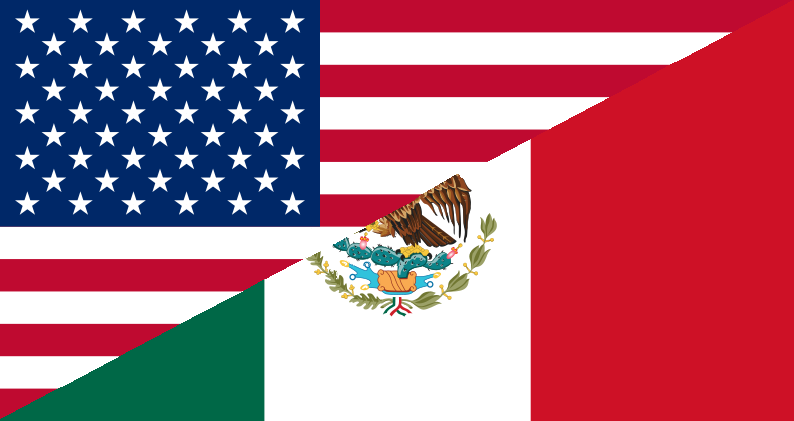
Saca Tu Bandera: a History of Latino Symbols in the Elgin Area
On May 27, 2023, a South Elgin High School administrator refused to allow a student wear a Latinx-themed scholarship stole as she walked across the stage during the school’s graduation ceremony.
Many in the Latina/o community were upset. In order to better understand this reaction, it is important to acknowledge the long history of tension over Latinx symbols in Elgin and the region.
Though Mexicans, Puerto Ricans, and other Latina/o people have lived in Elgin for decades, the Latinx population in the area soared in the 1990s and early 2000s. In fact, up to the present, Latinx suburban communities have been among the fastest-growing of any communities in the Chicagoland area.
As a result, different sites of racial conflict emerged in the 1990s and 2000s. Some white residents opposed the presence of Mexican flags, while many Latinx residents defended their right to celebrate their heritage.
During these years, controversy over Mexican flags was visible on the front pages of Elgin’s two local newspapers, the Courier-News and Daily Herald. Fights over these symbols — flags, sashes, certain arrangements of colors — represented unresolved tension amidst demographic change.
Put simply, as Elgin and the area grew more Latino, some residents panicked when they saw symbols of that change.
Uproar over Mexican Flags
In 2000, Guadalupe Perez, a 23-year-old Mexican American woman was featured on the Courier News’ front page after she flew two flags—one Mexican and another American—on a makeshift flagpole tree branch in front of her home in Carpentersville. Perez was celebrating September 16th, Mexican Independence Day.
Local residents became angry that the Mexican flag was flying above the American one and, according to Perez, started yelling at her from their cars. One resident called the Carpentersville police chief and the village manager to complain. When that didn’t work, the resident contacted the FBI, U.S. Marshals and U.S. Attorney’s office to report the placement of the flags. The journalist at the Courier-News, seemingly sympathetic to Perez’s critics, also placed a follow-up call to the U.S. Attorney’s office in Chicago to ask whether similar flag-related cases had ever been prosecuted.
The presence of Mexican flags had been irksome to some area residents for many years, often flaring up around Mexican Independence Day. Seven years earlier, the Courier News featured a front-page story claiming the presence of Mexican flags hung in public around the holiday created “pride and discomfort in Elgin residents.”
The journalist spoke with both Mexican and white Elgin residents. He found that some local Latinx businessmen like Abel Diaz proudly displayed both flags. But Diaz also criticized Mexican youth who he believed didn’t understand Mexican history and patriotism. Many other Latina/o interviewees wholeheartedly supported the presence of the Mexican flag.
However, some white residents criticized the presence of the Mexican flag. Local man Bob Krauss said flag waving by local Mexicans was “a little overdone.” Another resident asked, “What’s wrong with the American flag? They should go back to Mexico if they want to do that.”
In subsequent years, area residents complained through letters to the editor about a Mexican flag flying over La Movida, a Latino nightclub. One letter writer told the paper that “surely there is something you can do to get this flag properly displayed with a US flag over it.” Another person argued that the U.S. flag should always be flown above the Mexican flag and that residents should “call the police if there is no American flag flying above it.” The following year, an Elgin resident wrote to complain of a Mexican flag flying over an apartment building in downtown Elgin. This time, the newspaper’s editor, stepping beyond the presumption of objective journalism, promised that “the landlord will be contacted to see if this matter can be resolved.”
Despite this long history of complaints, Guadalupe Perez — the young Carpentersville woman who flew two national flags in front of her house — was unapologetic about raising the Mexican flag. After the Carpentersville police chief visited her home and “asked her to fix the problem,” Perez refused to budge. “It’s my First Amendment right,” she told the Daily Herald.
The Carpentersville city ordinance committee disagreed, and unanimously voted to instruct city staff to look into crafting an ordinance that would prohibit or fine actions like Perez’s.
The Larkin High School Incident
The most vitriolic controversy around flags came in 2005, when an Elgin high school student wrote a paper lashing out at the Mexican flag and Mexican students.
The student’s essay began by saying, “Certain holidays should not be celebrated in school specifically Mexican Independence Day.”
Referring to Mexican students, the essay continued by claiming, “They disrespect America…coming to school wrapped in Mexican flags…If they like Mexico so much, why don’t they go back to their poor, poverty-ridden piece of land they call a country.” The student claimed that during the previous year’s Mexican Independence Day, Latino students tossed an American flag on the ground and raised a Mexican flag.
The essay concluded by threatening, “If it was up to me, they would be expelled, beaten, wrapped in their flag, set on fire and tossed over the border.”
After an English teacher rejected the essay, it was found plastered in halls around the school.
At the time the student penned the essay, Larkin High School, one of five large high school in the massive Unified School District 46 and the state’s second largest district after Chicago Public Schools, had a student body that was close to 40 percent Latino.
Larkin High School parents were understandably upset and the school officials agreed to hold a meeting to address the situation. News reports of the meeting described parents as divided over the issue and possible school violence that might stem from it. Some of the over 100 parents who gathered in the school library on a Tuesday night worried of a violent “Columbine-like scene” in the future for the high school.
Parents interviewed by a local journalist expressed fears about “a tragedy happen[ing],” discrimination, and a “brewing resentment toward Spanish-speaking children by English-speaking students.” Another parent said administrators need to help students get along. Other parents argued that Larkin officials needed to address negative feelings toward minority students.
Some parents, however, were sympathetic to the student who wrote the essay. One parent referred to the alleged incident involving the Mexican flag as “treasonous.” Another parent argued that in the context of budget cuts, “some students see money being spent for non-English-speaking students and they see it as unfair.” Another Larkin parent called the student’s essay “personal reflections,” and argued that “the student who wrote that paper was obviously looking for attention…And they’re getting it. What they ‘think’ is still their right as an American.” The Daily Herald framed the incident as a free speech issue, and called the essay adolescent “musings that Mexican holidays should not be celebrated in American schools,” while ignoring the text’s threats of violence.
Soon after, local news reported that the U-46 school board voted to expel the student for the remainder of the school year. The vote took place in mid-May, which meant the student was expelled for about a month.
In the early 2000s, these kinds of tensions were also present at higher levels in the district. The same year Larkin High School was dealing with the violent essay about the Mexican flag, U-46 was sued for allegedly discriminating against minority students. A prominent education blog explains that, “several Hispanic and Black families, represented by the Mexican American Legal Defense and Educational Fund filed a federal class-action suit in 2005 that accused the district of discriminating against Hispanic students in school assignments, school closures and ELL services.”
The district later paid out a multi-million-dollar settlement to resolve the claims. A judge acknowledged that the gifted program was discriminatory, leading to a major overhaul in the district’s gifted program and other services.
Conclusion
As we discuss the South Elgin High School incident in 2023, it’s important to remember the longer, lost history of the backlash against Latinx symbols in our area. These conflicts are indicative of a larger conflict over the area’s identity. As Elgin and the region continues to become more Latinx, important questions remain:
Will Latina/os continue to be seen as outsiders by other residents, or will they be welcomed as fellow community members?
Will some residents harshly resist Latinx symbols, culture, and contributions, or will they warmly embrace them?
The answers to these questions are up to each of us.
In the meantime, Latinx residents should continue to raise their flags and celebrate their culture. Doing so only enriches our diverse community.
Sources: Courier-News, Daily Herald (Gail Borden Public Library Microfilm)


